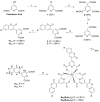New Coumarin Dipicolinate Europium Complexes with a Rich Chemical Speciation and Tunable Luminescence
- PMID: 33652775
- PMCID: PMC7956443
- DOI: 10.3390/molecules26051265
New Coumarin Dipicolinate Europium Complexes with a Rich Chemical Speciation and Tunable Luminescence
Abstract
Europium (III) luminescent chelates possess intrinsic photophysical properties that are extremely useful in a wide range of applications. The lack of examples of coumarin-based lanthanide complexes is mainly due to poor photo-sensitization attempts. However, with the appeal of using such a versatile scaffold as antenna, especially in the development of responsive molecular probes, it is worth the effort to research new structural motifs. In this work, we present a series of two new tris coumarin-dipicolinate europium (III) complexes, specifically tailored to be either a mono or a dual emitter, tuning their properties with a simple chemical modification. We also encountered a rich chemical speciation in solution, studied in detail by means of paramagnetic NMR and emission spectroscopy.
Keywords: chemical speciation; coumarin; dipicolinate; europium complex; luminescence.
Conflict of interest statement
The authors declare no conflict of interest.
Figures







References
-
- De Bettencourt-Dias A. In: Luminescence of Lanthanide Ions in Coordination Compounds and Nanomaterials. de Bettencourt-Dias A., editor. John Wiley & Sons Ltd.; Chichester, UK: 2014.
-
- Wei C., Ma L., Wei H., Liu Z., Bian Z., Huang C. Advances in luminescent lanthanide complexes and applications. Sci. China Technol. Sci. 2018;61:1265–1285. doi: 10.1007/s11431-017-9212-7. - DOI
-
- Ning Y., Zhu M., Zhang J.-L. Near-infrared (NIR) lanthanide molecular probes for bioimaging and biosensing. Coord. Chem. Rev. 2019;399:213028. doi: 10.1016/j.ccr.2019.213028. - DOI
MeSH terms
Substances
Grants and funding
LinkOut - more resources
Full Text Sources
Other Literature Sources

